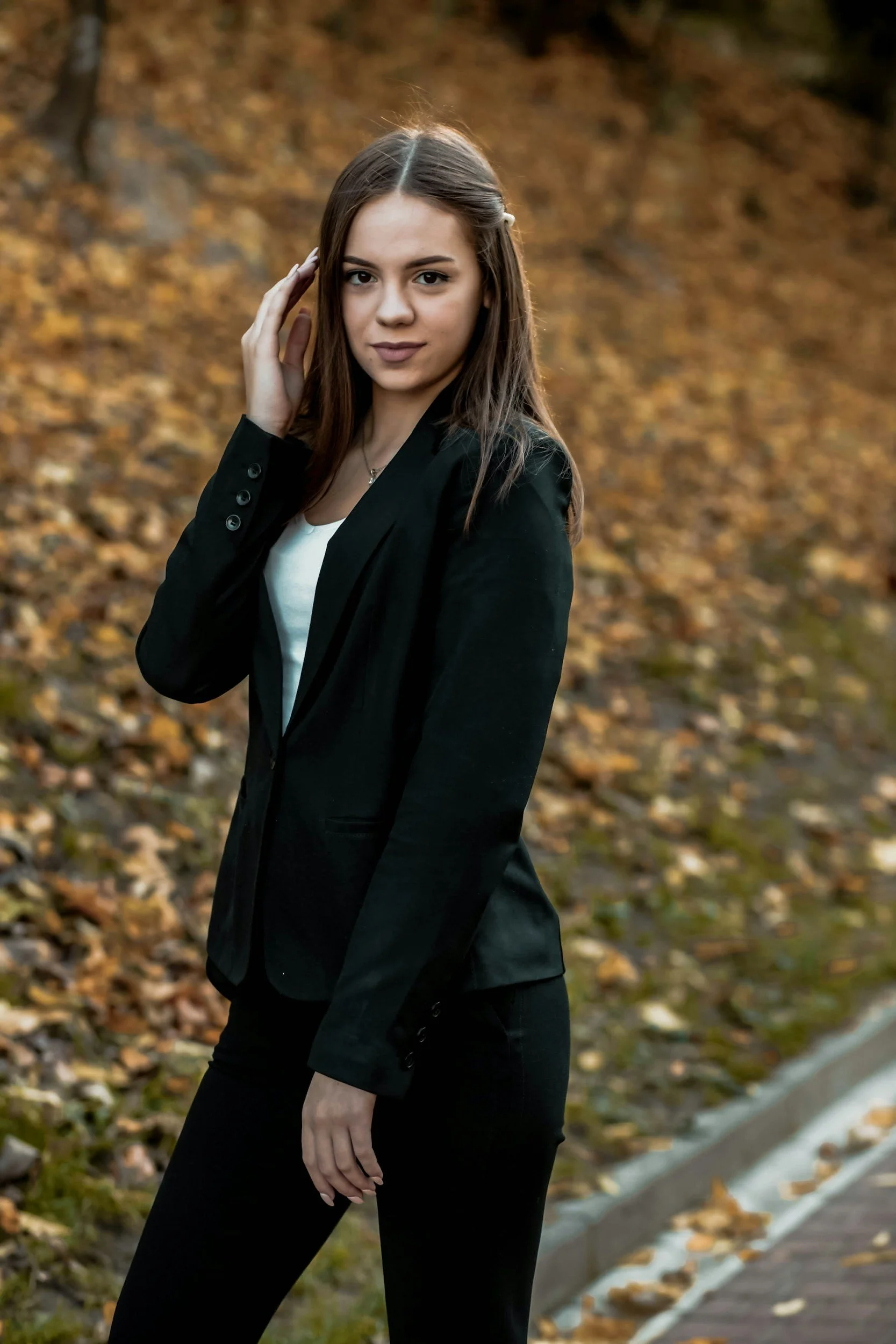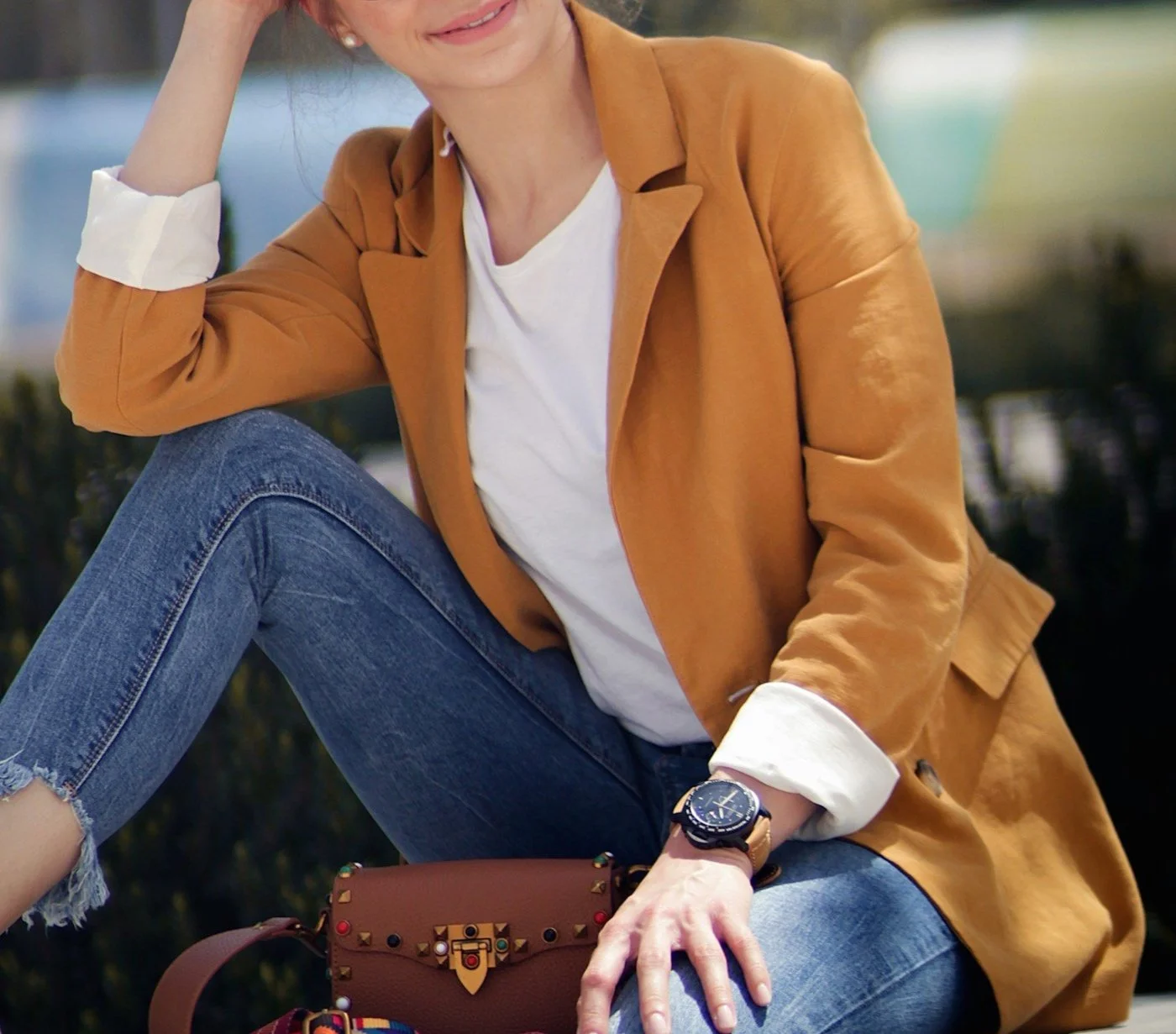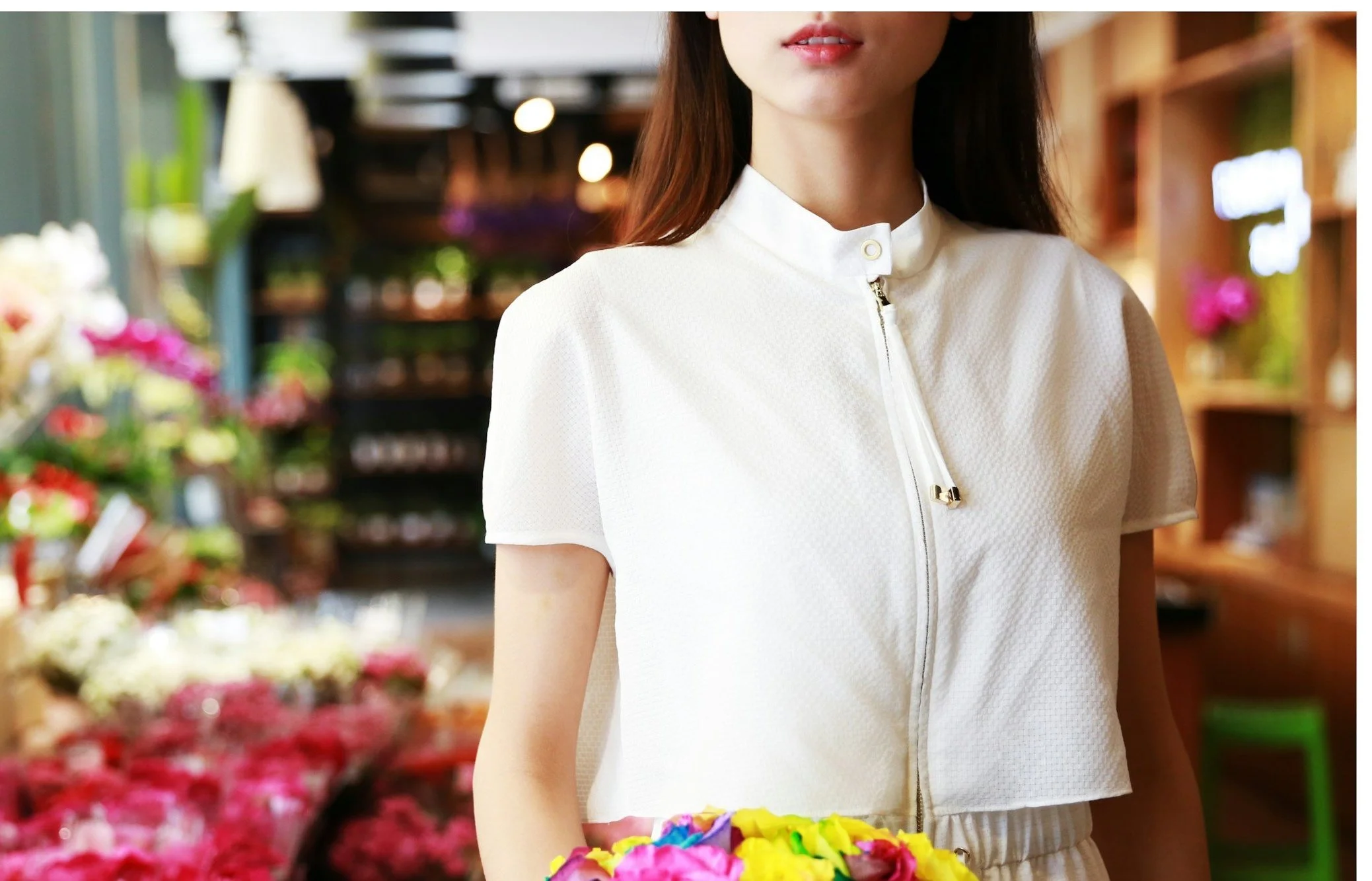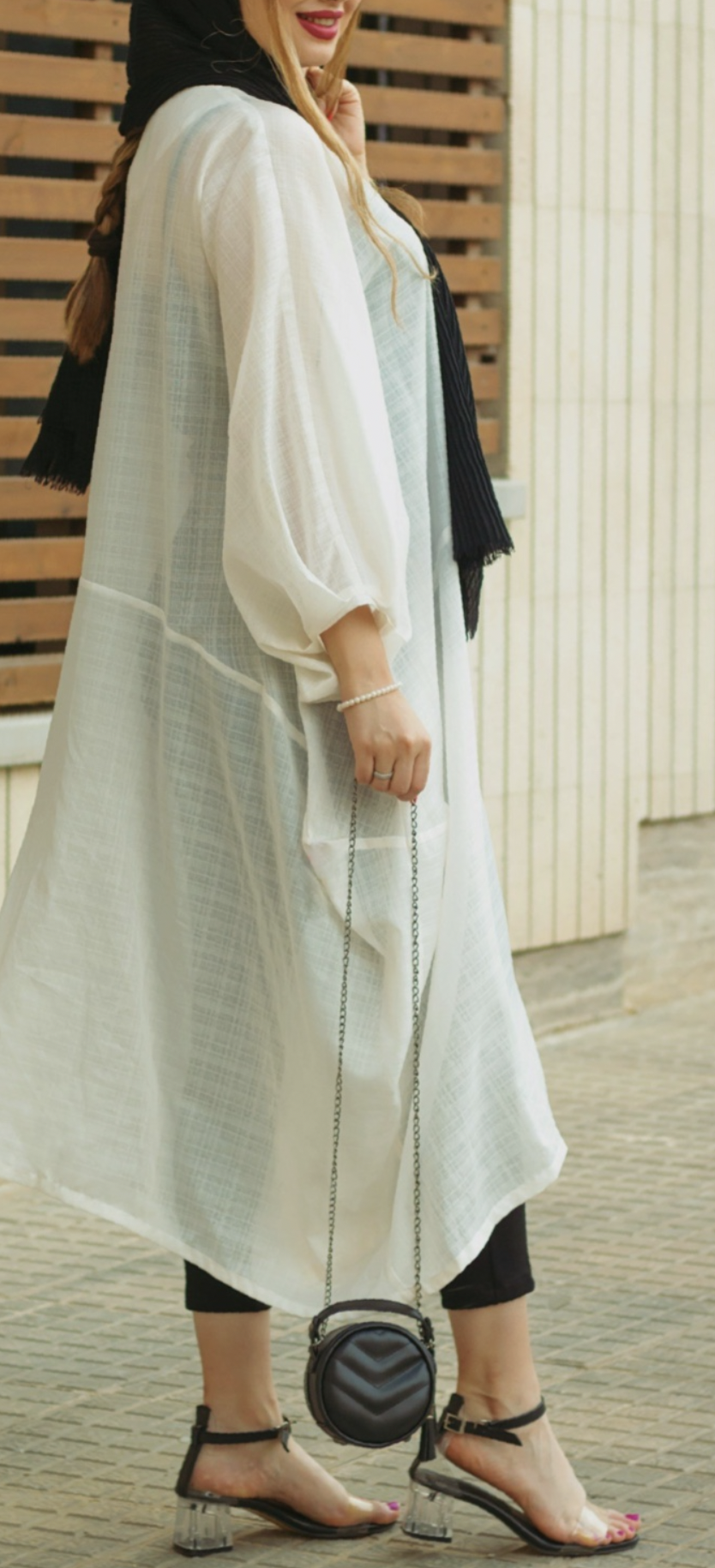Basics for every style essence, part 2
In Part 1, we covered how to find the perfect white tee for every style essence.
Part 2 is about what to layer over your tee.
Quick recap
As covered in Part 1, creating a capsule wardrobe—a wardrobe centered around Classic basics—is great for a lot of reasons but has a major downside: if you don’t have the Classic essence, then a traditional capsule wardrobe will be filled with clothes that don’t actually flatter you.
The solution? Choose pieces that are perfect for your style essences and that simultaneously mimic the look of Classic basics.
Blazers, jackets, and cardigans
As the temperature drops, you’ll want a versatile indoor jacket, blazer, or cardigan, ideally something that can be dressed up or down.
Here’s a version of that for every essence.
Classic Blazer
A simple, polished Classic blazer.
What makes this Classic: it’s extremely conventional in vibe and silhouette. Nothing is particularly elongated or cropped or tight or loose, and it has only very minimal detail (the barely-noticeable black buttons on the sleeves).
Classic blazers are appropriate for formal settings but also look really cool unbuttoned and worn over basic tees with slouchy jeans. One of the best parts about Classic basics is that their simplicity creates versatility, and they easily transition from formal to casual.
Dramatic Blazer
The Classic blazer becomes fully Dramatic by incorporating a much longer silhouette, including sleeves that stretch nearly to the fingertips:
Dramatic style sometimes reads as an edgier version of Classic style. Both essences are great in tailored pieces and minimalism, but Classic fashion will typically appear highly basic and standard in silhouette, whereas Dramatic fashion typically has extra length and other unique elements that add an edgy feel.
With its long, straight, and slightly oversized but still very sleek silhouette, this blazer is now fully Dramatic. It’s much edgier than the Classic blazer, but the neutral color and minimal detail still make this piece highly versatile.
This blazer can obviously work for a formal setting, but Dramatic blazers also look really cool layered over more casual tops, like Gamine graphic tees.
Above, pairing it with a basic Classic turtleneck and shorts makes a perfect look for a Dramatic Classic Gamine.
How to make it Natural:
Natural Jacket
What makes this Natural: the combination of the earth tone color, slightly oversized, slouchy fit, and styling (unbuttoned with sleeves rolled).
Dramatic and Natural jackets can look similar, but a Natural jacket will feel much more relaxed and carefree—often achieved with gentler colors, casual fabrics, laidback styling, and a looser, wider, less stiff silhouette.
Here the jacket is casualized with frayed jeans, but you could also pair it with a dress or quintessential autumn plaid skirt, and un-roll the sleeves for a more formal feel.
Let’s make it Gamine:
Gamine Jacket
This stark white jacket is intriguing because Gamine is so much associated with bold colors, busy patterns, and other elements that have a hard time feeling “basic.”
What makes this jacket completely Gamine? Every aspect of its silhouette is so committed to having Gamine elements, from the mock-neck collar to the short straight sleeves to the overall straight, sharp, cropped silhouette.
If you’re having trouble finding something like this jacket, short-sleeve or cropped blazers are often partly or fully Gamine, especially if the lapels also have short, angular elements.
And of course you can choose a darker color if white feels impractical or not suited to the season or your aesthetic.
How to make it Romantic:
Romantic Jacket
Our Gamine jacket transforms to be fully Romantic, with the angles becoming curves.
Here the low, curvy neckline approximates a sweetheart shape (possibly the most flattering neckline style for Romantic), and the bust is emphasized with gathers.
Instead of being angular and boxy, the silhouette becomes fitted, with detail resembling corset boning. We can’t see the jacket’s length, but either a cropped or full-length silhouette works for Romantic when the rest of the elements are as glam as they are here. A jacket with a large peplum can also be Romantic.
The sleeves appear to be a puff sleeve style, which tends to be more associated with Ingenue but to me is reading as Romantic here in the context of all the other Romantic elements (admittedly it’s very hard to tell with the model’s pose). A version with typical length or three-quarter length sleeves would also be fully Romantic.
As with the Gamine jacket, you could choose a darker neutral if that better fits your aesthetic.
How to make it Ethereal:
Ethereal Cardigan
If you’re searching for an Ethereal basic layering piece, one of the easiest styles to find is a long, narrow, and sheer or semi-sheer cardigan.
This one is especially great because of the bishop sleeves that add some Ethereal drapiness and slight volume, while keeping a relatively narrow shape.
Can more structured layering pieces, like jackets, be Ethereal? It’s definitely possible—for instance, you could find a blazer with sheer sleeves or panelling in more lightweight fabric than a typical blazer.
But since Ethereal is so defined by unconstructed silhouettes, it can be tough for any kind of inherently structured jacket to fully embody Ethereal.
Pale colors are also iconic for this essence, but if everything else about your cardigan—like the sheer, flowy fabric and the long silhouette—is Ethereal, then a darker color, even black, can still read as fully Ethereal.
How to make it Ingenue:
Ingenue Sweater
What makes this fully Ingenue: the delicate knit fabric with the cropped silhouette, scalloped hem, and narrow ties looped into bows.
The only non-Ingenue aspect is that the model forgot her basic Tee, but it does look super trendy and cool styled like this. Wearing it like this works for a Romantic Ingenue because of the sexiness.
To make it fully Ingenue, you could easily layer it over really any plain shirt or camisole. You could choose a shirt very close to the color of your skin tone if you want it be fully Ingenue while keeping a similar effect to what the model has here.
Should you dress seasonally?
I’ve been thinking about this question recently, especially as I see beautiful autumn-themed fashion in warm muted tones and quintessential autumn plaid prints.
Traditional autumn fashion doesn’t necessarily flatter every style type (or every color season)—should you still wear it even if it isn’t best on you?
Beyond the obvious point that you should probably dress in something you won’t freeze in, I don’t think there’s a right answer.
In honor of the Ethereal style essence, which can have a hard time being flattered by structured jackets, here’s some unstructured thoughts on trends.
Should you follow trends?
I really ultimately have no answer to this question because it’s so subjective—I just don’t think there’s a single right answer. I’m also not even totally sure of my opinion, but here’s initial thoughts.
The question of whether to follow trends seems to fit into a larger theme of style analysis in general—should you dress more like what you see on everyone around you, or should you dress based on what looks good on you, even if your personal style is really different than the mainstream?
Again, I don’t think there’s one right answer. Obviously I’m biased because I love style analysis. And I think it’s obvious that there can be bad reasons to follow trends, like if you really loathe the trends but feel compelled to wear whatever everyone else is wearing out of fear of being different. But I don’t think there’s anything inherently wrong with—and I think there’s a lot that’s positive about—being inspired by what others are wearing and mimicking aspects of their style in your own look.
Arguably a huge part of being interested in fashion is being interested in trends. Though I don’t think it has to be that way for everyone.
The main thing that gives me a bad feeling about trends in general is that if you apply the idea of “trends” to certain contexts outside of fashion, the result often seems clear that making decisions based on trends is far from ideal.
Like if you’re selecting a college major or a job, you probably want to choose largely based on what you have an aptitude for, rather than what all your friends or celebrities or random passerby are doing. Same with choosing a romantic partner or making any other big life decision. You want to choose something that fits you, not just something that’s popular.
Style analysis really does seem to evoke questions about individual vs. popular, and also about individual vs. environment, especially with the seasonal dressing debate—should I dress based on what I see around me, or dress based on what will flatter me?
And of course, choosing what to wear isn’t the same as choosing a job or a life partner. “It’s not that deep,” you might say, and honestly I agree.
There is a part of me that wonders, though, if there’s a connection, however small, or at least there can be for some people, between choosing the wrong outfit and choosing the wrong job or relationship partner.
That might sound like the biggest leap ever, but there are so many people who are unhappy with various life choices, and there’s so many reasons for that—and part of it may be that people often aren’t instructed to really think about what they want and what suits them. We may make choices because it’s convenient or because we’re not sure of a viable alternative or because we’re thinking about how our family or friends or society may see us, and all of those concerns can be very legitimate and important. But if we want to choose the option that’s really going to make us fulfilled, we probably can’t choose based entirely on external considerations. We probably have to think about who we are, what we’re good at, what we value, and base our decisions at least partly on that.
So one reason I like style analysis is that it’s a really great metaphor, a metaphor about not making decisions just based on your external environment and on what everyone else is doing.
I don’t think it’s bad to follow trends. I think a lot of aspects of it are positive. They’re fun, and they can provide a sense of community and connection and also help make people more open-minded to diverse styles.
But the flip side is that they can also lead to close-mindedness toward anything not on trend. And sometimes we might want so badly to feel like we’re part of a certain group that we sacrifice things we really love.
Not to mention it can cost an unrealistic amount to rework your wardrobe every time new trends come around—which illustrates the benefits both of capsules wardrobes and of style analysis, of finding pieces that you’re confident in no matter the season.
Part three of this series coming soon.






